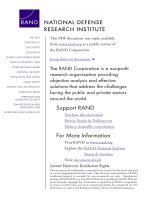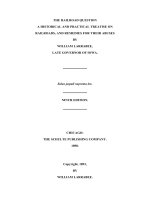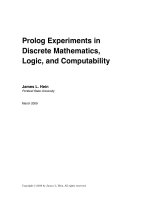combining discrete orthogonal moments and dhmms for off-line handwritten chinese character recognition
Bạn đang xem bản rút gọn của tài liệu. Xem và tải ngay bản đầy đủ của tài liệu tại đây (2.36 MB, 6 trang )
COMBINING
DISCRETE
ORTHOGONAL
MOMENTS
AND
DHMMS
FOR
OFF-LINE
HANDWRITTEN
CHINESE
CHARACTER
RECOGNITION
Xianmei
Wang,
Yang
Yang,
and
Kang
Huang
School
of
Information
and
Engineering
University
of
Science
and
Technology
Beijing
No.
30,
Xueyuan
Road,
Beijing,
China,
100083
plum-wanggtom.com
Abstract
moments
requires
a
coordinate
transformation
which
may
Discrete
orthogonal
moment
set
is
one
of
the
novel
also
cause
precision
loss.
feature
moment-based
descriptors
for
image
analysis.
Some
researchers
such
as
MuKundan
et
al.
have
The
Tchebichef
moments
and
Krawtchouk
moments
are
suggested
the
use
of
discrete
orthogonal
moments
to
the
two
representatives
in
this
class.
This
paper
studies
overcome
the
problems
associated
with
the
continuous
the
performance
of
the
two
discrete
orthogonal
moments
orthogonal
moments.
In
the
past
few
years,
some
in
the
recognition
of
off-line
handwritten
Chinese
amount
different
discrete
orthogonal
moments
are
proposed
such
in
words
under
Discrete-time
Hidden
Markov
Models
as
Tchebichef
moments
[5-7]
and
Krawtchouk
moments
(DHMMs)
framework.
The
lower
order
moments
are
[8]
[9].
These
discrete
orthogonal
moments
are
directly
employed
asfeatures.
A
serial
of
experiments
are
carried
defined
in
the
image
coordinate
space
[(O,
0),
(N-1,
M-
out
to
compare
their
performance
with
that
of
the
1)].
The
implementation
of
the
discrete
orthogonal
continuous
orthogonal
movements
such
as
Zernike
and
moments
doesn't
involve
any
numerical
approximation
Legendre.
Experimental
results
suggest
that
the
and
coordinate
transformation.
These
properties
make
recognition
performance
of
two
discrete
orthogonal
discrete
orthogonal
moments
much
more
suitable
for
2-D
moments
is
higher
than
that
of
the
continuous
discrete
images
as
pattern
features.
It
has
been
shown
that
these
moments.
In
additional,
different
values
of
the
number
of
discrete
orthogonal
moments
have
better
performance
zones,
observation
symbols
and
states
are
also
used
to
than
the
conventional
continuous
orthogonal
moments
find
the
better
model
structure
for
the
new
approach.
for
image
reconstruction
[5]
[8]
[9].
As
we
know,
for
off-line
handwritten
character
Keywords:
Discrete
orthogonal
moments;
DHMMs;
Off
recognition,
most
of
obstacles
remain
in
the
strong
line
handwritten
character
recognition.
variability
of
the
handwriting
styles.
Hidden
Markov
models
(HMMs)
are
stochastic
models
which
can
deal
with
dynamic
properties
and
variations
among
human
1.
INTRODUCTION
handwriting.
Since
the
last
decade,
HMMs
have
been
widely
used
for
off-line
handwritten
character
Moments
with
orthogonal
basis
functions,
introduced
recognition.
There
are
basically
two
classes
of
HMMs
by
Teague
[1],
have
minimal
information
redundancy
in
depending
of
the
type
of
observation
sequence,
i.e.
a
moment
set.
In
this
class,
the
two
most
important
discrete-time
HMMs
(DHMMs)
and
continuous-time
orthogonal
moments
which
have
been
extensively
HMMs
(CHMMs).
Both
of
them
have
been
successfully
researched
in
pattern
recognition
field
are
Zernike
applied
to
the
recognition
of
off-line
handwritten
moments
and
Legendre
moments
[2-4].
Now
they
have
character.
However,
DHMMs
are
more
attractive
because
been
widely
used
as
fundamental
features
for
character
of
their
low
computational
cost.
recognition.
But
both
Zemike
and
Legendre
moments
In
this
paper,
we
proposed
a
method
by
extracting
belong
to
the
class
of
continuous
moments.
For
digital
discrete
orthogonal
moments
feature
for
DHMMs-based
images,
their
computation
requires
numerical
character
recognition.
Then
we
study
and
compare
the
approximation
of
continuous
integral.
This
process
can
discrete
orthogonal
moments
for
unconstrained
off-line
cause
error,
especially
when
the
order
of
the
moments
handwritten
Chinese
amount
in
words
recognition
with
increases.
Additionally,
the
use
of
Zernike
and
Legendre
12
Chinese
words.
In
the
literature
of
image
processing,
'
~~~~~~~~~it
is
well
established
that
the
important
and
perceptually
Proc.
5th
IEEE
Int.
Conf.
on
Cognitive
Informatics
(ICCI'06)
Y.Y.
Yao,
Z.Z.
Shi,
Y.
Wang,
and
W.
Kinsner
(Eds.)78
1
-4244-0475-4/06/$20.OO
@2006
IEEE78
significant
information
of
an
image
lies
in
the
lower
of
continuous
integrals,
and
does
not
require
coordinate
order
coefficients.
The
higher
order
coefficients
can
be
space
transformations.
discarded
without
significantly
affecting
the
quality
of
the
image.
So
moments
of
lower
order
are
extracted
in
2.2
Tchebichef
Moments
our
method
as
the
feature
descriptors.
The
organization
of
this
paper
is
as
follows.
Section
2
Tchebichef
moments
are
a
set
of
moments
formed
by
presents
the
definition
of
discrete
orthogonal
moments
using
Tchebichef
polynomials
as
the
basis
function
set
including
Tchebichef
moments
and
Krawtchouk
[5].
moments.
Our
HMMs-based
recognition
approach
The
definition
of
the
nth
order
Tchebichef
combining
discrete
orthogonal
moments
for
off-line
polynomial
is
handwritten
character
recognition
is
provided
in
section
3.
Section
4
presents
experimental
results
of
our
method.
-n,
-X,
1+
n
Section
5
then
concludes
this
paper.
t,
(x)=(I-N),,
3F2
1
i-N
1
(4)
2.
DISCRETE
ORTHOGOLNAL
x,n
=
0,1,2,
N-1.
MOMENTS
and
the
function
p
Fq
(.)
is
defined
as
The
discrete
orthogonal
moment
functions
are
based
r
_ _
_k
on
discrete
polynomials
set
which
is
orthogonal
in
the
ap
(a1,a2,.
.
)k
zk(5)
discrete
domain
of
the
image
coordinate
space.
In
this
q
k=.,
bq)k
k!
section,
we
first
introduce
the
theorem
on
the
discrete
orthogonal
polynomials
and
discrete
orthogonal
where
symbol
(a)k
is
given
by
moments,
followed
by
Tchebichef
moments
and
Krawtchouk
moments.
ak
=a(a
+
I)(a
+
2)
(a
+
k
-1)
(6)
2.1
The
Generalized
Discrete
Orthogonal
For
Tchebichef
polynomials,
the
weight
function
Polynomials
and
Moments
cw(x)
and
squared
norm
p(n)
are
given
by
w(x)1
(7
Suppose
{f,
(x)}
is
a
set
of
discrete
orthogonal
N
+
n7
polynomials,
then
it
satisfies
following
condition
[5].
p(n,
N)
=
(2n)!
2n
0
°
<ml
n
<N-1
(8)
N-1
Z
)(x)f,
(x)fm
(x)=
p(n;
a,
b)dmn
a
<
x
<
b
(1)
Because
the
value
of
Tchebichef
polynomial
grows
X=o
rapidly
as
Nn
[5],
a
set
of
weighted
Tchebichef
where
c(x)
is
called
the
weight
function
and
p(n)
the
polynomials
is
introduced
by
R.
Mukundan,
S.
H.
Ong
squared
norm.
and
P.
A.
lee
to
ensure
the
stability
of
Tchebichef
The
generalized
discrete
orthogonal
moments
of
order
polynomials.
(n
±
m)
in
term
of
f,
(x)
for
an
image
with
intensity
The
definition
of
weighted
Tchebichef
polynomial
function
I(x,y)
(
O<x<N-1
,
O<y<M-1
)
are
It,(x)}
is
defined
as
t,
(X)
1
N-IM-1
8
(n,
N)
F
=
E
1
o°(x)fn
(x)fm
(y)I(x,
y)
(2)
Fnm
-
p(n,
N)p(m,
M)
x=O
y=o
where
,8(n,
N)
is
a
suitable
constant
to
maintain
the
n
=0,1,2,
N
-
1,m
=0,1,2,
,M
-1.
value
of
weighted
Tchebichef
polynomial
within
the
For
a
given
moment
function
Fnm
,
p(n,
N)
is
rangeof[-1,1].
nm
~~~~Under
(9),
p(n,
N)
also gets
modified
by
independent
of
x.
So
(2)
can
also
be
written
as
'
9
Fnm
=EE
p(n
N)p(
M)
(3)
p,,
(n,
N)
Ikn,
N
(I
0)
We
can
see
that,
the
moment
definition
given
in
(2)
or
There
are
some
choices
for
the
function
,6(n,
N)
[8-9].
(3)
completely
eliminates
the
need
for
any
approximation
Tesmls
omi
789
The
Tchebichef
moments
of
order
(n
+
m)
in
term
of
3.
HMMS
FOR
CHARACTER
tn(x)
for
an
image
with
intensity
function
I(x,y)
RECOGNITION
(0.x<
N-1,
0.y.M-1),are
definedas
HMMs
have
been
widely
used
in
the
field
of
pattern
1
N-IM-1
recognition.
They
are
stochastic
models
for
time
Tn
=
E
tn
(X)t,,,
(y)I(x,
Y)
sequences,
which
were
introduced
and
studied
in
the
late
5(n,N)5(m,M)
x=O
y=O
1960s
and
early
1970s
[10]
[11].
Their
original
NIM1
tl
(x)t,(Y)
I(x,
)
(12)
application
was
in
speech
recognition.
During
the
last
x=O
y=o
p(n,
N)p(m,
M)
decade,
HMMs
have
become
popular
in
off-line
character
N-IM-1t
(X)t
(y)f8(n
N)U8(m
M)
recognition
system.
Like
all
other
classification
methods,
(X)trn
~
N)13(m,
Y
^I(x,
y)
Feature
extraction
is
a
key
for
a
HMMs-based
classifier.
x=O
y=0
p(n,
N)p(m,
M)
In
this
paper,
we
studied
discrete
orthogonal
moments
as
n
0,1,2,
N
-
1,
m
=
0,1,2,
,
M
-1.
features
under
HMMs
framework
for
off-line
handwritten
Chinese
character
recognition
with
a
limited
2.3
Krawtchouk
Moments
lexicon.
The
set
of
Krawtchouk
moments
was
first
introduced
3.1
The
Introduction
of
DHMMs
by
Yap
et
al.
[8]
[9].
The
kernel
of
Krawtchouk
moments
consists
of
the
set
of
Krawtchouk
polynomials.
Here
the
HMMs
are
referenced
as
DHMMs.
A
The
definition
of
the
nth
order
Krawtchouk
DHMM
is
a
probabilistic
model
that
describes
a
random
polynomial
is
[8]
sequence
O
=
1,02,
,
T
as
the
indirect
observation
of
a
hidden
random
sequence
Q
I
Q12
,
QT,
where
this
Kn(x;p,N)
,
pak,n,p
F
fl,
=
x
(13)
hidden
process
is
Markovian.
A
DHMM
/2
{A,
B,2T}
is
k=O
-
N
P)
characterized
by
following
elements:
where
x,
n
=
0,1,2, N,
N
>
0,
p
E(0,1)
.
N:
the
number
of
states
in
amodel;
The
functions
Fq
and
symbol
are
given
by
(5)
M
the
total
number
of
observation
symbols;
The
functions
andsym
lak
A
(a,
)NN
:
the
state
transition
probability
matrix.
and
(6)
respectively.
and
(6)
respectively.
~~B=(b
)Am
:
the
observation
symbol
probability
For
Krawtchouk
polynomials,
the
weight
B
m
(ti
sl
function
c(x)
and
squared
norm
p(n)
are
given
by
matrix
in
each
state
;T
=
(;Ti
)N
the
initial
state
probability
matrix.
NNx
c(x;
p,
N)
=
K
x
(1
-
p)Nx-
(14)
3.2
System
Overview
n
n
p(n;
p,
N)
=
(_P)n
rl
,
0
<
n
<
N
-1
.
(15)
At
the
top
level,
a
traditional
DHMMs-based
character
(-N)n
K
P
)
recognition
system
can
be
divided
into
two
basic
functional
components:
training
and
recognition.
Both
Same
to
the
Tchebichef
polynomials,
instability
also
training
and
recognition
share
a
common
pre-processing,
exists
among
Krawtchouk
polynomials.
The
definition
of
frames
generation
and
feature
extraction
stage.
weighted
Krawtchouk
polynomial
{Kn(x;p,N)}
is
In
the
training
phase,
after
applying
pre-processing
steps
including
binarization,
noise
removal,
boundary
Kn
(x;
~,
N)
x;
p,
N)
(16)
obtainment,
and
size
normalization,
an
image
p(n;
p,
N)
I(x,
y)
(0
<
x,
y
<
L)
is
segmented
into
T
frames
The
Krawtchouk
moments
of
order
(n
±
m)
in
term
of
frame(i)
(1
<
i
<
T)
using
sliding
window
technique
to
suit
for
DHMMs
recognition
engine.
The
feature
weighted
Krawtchouk
polynomials
for
an
image
with
extraction
module
then
transforms
a
frame
intensity
function
I(x,
y)
and
N
x
M
pixels
are
defined
as
image
frame(i)
into
a
feature
vector
fv(i),
which
is
then
Krn
m
=E
Kn(x;
p1
,N
-
)Krn
(y;
p2
,M
-
)I(x,y)
(17)
translated
into
a
symbol
O(i)(l
.<i<.T)
by
clustering
x=O
y=o
algorithm
(VQ).
The
codebook
with
M
code
words
output
by
VQ
is
kept
for
further
use
to
quantized
feature
790
vectors
into
symbols.
By
above
steps,
a
character
pattern
is
translated
into
a
sequence
of
'
Frame(i)
symbols
0
=
0(1),
0(2) ,
O(T)
.
For
each
pattern
class,
Z n
1
observation
sequences
0
to
adjust
model
Zonei
parameters
{A,
B,;T},
so
that
the
probability
of
the
train
.Zone
Z
observation
sequences
P(O
/2)
is
maximized.
In
the
recognition
phase,
after
pre-processing,
frames
generation
and
feature
extraction,
T
sequential
feature
According
to
(12)
and
(17),
it's
obvious
that
if
the
vectors
are
obtained.
Then
these
feature
vectors
are
highest
order
of
moments
is
d,
the
dimension
of
a
local
quantized
into
the
possible
codebook
vectors.
Thus,
each
feature
vector
for
a
zone
is
word
image
is
represented
by
a
sequence
of
corresponding
observation
symbols.
The
resulting
D'=
(d
+
1)
x
(d
+
2)72.
(19)
observation
sequence
is
then
used
to
calculate
the
log-
likelihoods
for
the
model.
The
word
associated
with
an
Then
the
total
dimension
of
a
feature
vector
for
a
HMM
of
the
highest
log-likelihood
is
declared
to
be
the
frame
is
recognized
word.
D
=
Z
x
D'.
(20)
In
our
classifier,
the
size
of
a
normalized
image
was
64
x
64.
The
length
of
an
observation
symbol
sequence
In
our
method,
only
discrete
orthogonal
moments
with
was
set
to
T
=
8.
The
K-Means
algorithm
was
employed
lower
orders
from
0
to
3
are
extracted
in
a
zone.
For
a
for
VQ
because
of
its
simpleness.
The
model
estimation
given
zone
Zone(j)
(
1
<
j
<
Z
)
of
a
frame
and
matching
module
were
performed
by
Baum-Welch
frame(i)
(1
<
i
<
8
),
(12)
and
(17)
can
be
written
as
algorithm
and
Viterbi
algorithm
respectively
[12].
1
~~~x)t~
)I(W-lH-1
3.3
The
Selection
of
Model
Topology
Tp(nn,
W
-
l)5
(m
H
)
lEEO
,
I'(
The
transition
topology
becomes
an
important
part
for
w-IH
(21)
the
recognition
system
and
a
suitable
topology
can
make
Knm
(i,
j)
Z Z
Kn
(x';
p1,
W
-
I)Km
(Y;
P2,
H
-
I)I(x,
y)
a
significant
increase
in
recognition
accuracy.
In
x=O
y=O
character
recognition,
left-right
models
are
widely
used
(22)
because
they
well
suit
people's
writing
habit.
In
this
paper,
we
choose
the
left-right
topology
with
1
skip
where,
x'=x-(i-l)xW,
y'=y-(j-1)xH.
(shown
in
Fig.
1)
to
model
the
image.
And
the
number
of
Because
the
maximum
order
(n
+
m)
is
3,
a
local
states
and
observation
symbols
is
set
to
different
values
Tchebiechef
feature
vector
Tz(i
j)
or
a
local
to
find
the
better
one
in
later
experiments
(see
Section
3).
Krawtchouk
feature
vector
Fz
(i,
j)
extracting
from
a
zone
can
be
written
as
Qe
~~~~~~~~~~~~~~~~TZ(
j)
=
{TOO(i
j),
TO(I
0
j),
FIO
0,
j),
TI
I
0
j),
T02(i,
j),
T20
(,1
{,T30
(i,j),
T03
(i,2j),
'7
(i,j),
T21
(i),
j)
(23)
Fig.
1.
The
left-right
topology
with
1
skip
or
3.4
Extracting
Discrete
Orthogonal
Moments
Fz
(i,
j)
=
{FOO
(i,
j),
FO
(i,
j),
FO
(i,
j),
Fl
1
(j,j),
F02
(,1
j),
Feature
under
DHMMs
Framework
In
order
to
detail
the
image,
zoning
sliding
window
The
feature
vector
for
a
frame
frame(i)
is
formed
by
technique
is
used
to
extract
the
sequential
feature
vectors.
Each
frame
is
divided
into
Z
equal-sized
zones
from
up
lirking
the
Z
local
feature
vectors.
That
is
to
say,
a
to
down
as
shown
in
Fig.
2.
frame
vector
fi
-
T(i)
or
fi
-
K(i)
can
be
written
as
Then
the
width
W
and
the
height
H
of
a
zone
are
given
by
f
i-_
T(i)=
{T
(i,1),
T
(i,2),.
,
T_
(i,
T)}
(25)
W
=L
IT
fv
K(i)
={Kz
(i,l),
Kz(i,2),
,
Kz(i,
T)}
(26)
H
=LIZ
(8
791
3.5
The
Acceleration
of
Feature
Extraction
tested.
The
results
are
shown
in
Table
1
and
Table
2.
It
should
be
pointed
out
that
the
recognition
speed
in
our
According
to
(12),
the
computation
of
Trnm
involves
paper
doesn't
include
the
time
used
for
pro-processing
and
the
saving
of
the
final
recognition
results.
the
computation
of
the
function
t
(x)
and
p(n,N).
And
each
function
consists
of
several
multinomials
for
Table
1.
Recognition
accuracy
of
using
different
multiplication
operation,
which
will
require
much
orthogonal
moments
with
M=64,
Z=4
computation
time.
In
order
to
speed
up
the
process
of
ate
Number
feature
extraction,
the
coefficients
t
(x)
and
p(n,N)
for
Mome
>
6
9
12
Tchebichef
moments
are
computed
and
saved
in
advance.
Tchebichef
91.42
92.69 92.36
Then
in
the
feature
extracting
stage,
all
coefficients
are
loaded
to
memory
from
hard
disk
and
used
as
constants
Krawtchouk
89.89
90.89
90.81
to
join
the
real-time
calculation
of
Tchebichef
moments.
Zernike
86.47
89.55
89.39
The
same
acceleration
method
is
also
used
in
the
Legendre
86.19
88.72
88.03
extraction
process
of
Krawtchouk
moments.
Table
1
indicates
that
the
recognition
accuracy
of
4.
EXPERIMENTS
AND
ANALYSIS
Tchebief
and
Krawtchouk
moments
is
higher
than
that
of
the
other
two
continuous
moments, no
matter
the
number
Our
work
detailed
in
this
paper
deals
with
the
of
states
is
set
to
6,
9
or
12.
It
also
can
be
seen
that
the
recognition
of
the
isolated
unconstrained
off-line
highest
recognition
accuracy
can
be
achieved
by
setting
handwritten
Chinese
amount
in
words
including
Chinese
N
to
9.
However,
the
differences
in
accuracy
rate
for
the
characters
from
V
to
X
and
JU.
All
the
handwritten
values
of
N
with
9
and
12
are
small.
Additionally,
Table
character
samples
used
in
the
following
experiments
1
also
indicates
that
the
recognition
accuracy
of
Legendre
were
collected
by
our
laboratory.
They
are
written
by
moments
is
the
lowest.
numerous
writers
and
in
various
writing
styles.
There
are
totally
11,966
binary
digital
images.
We
used
8,366
Table
2.
Recognition
speed
of
using
different
images
for
training
and
3,600
images
for
testing.
orthogonal
moments
with
M=64,
Z=4
All
experiments
were
performed
on
a
COMPAQ
Evo
tate
Number
N610C
notebook
PC
with
768M
memory
and
1.8GHz
M
oen
6
9
12
CPU.
All
programs
are
written
with
Matlab
6.0
language.
E
Because
of
its
simplest
form,
(11)
was
selected
for
the
Tchebichef
513
477
442
function
8'(n,
N)
to
maintain
the
equal
weight
of
Krawtchouk
515
478
450
different
Tchebichef
moments.
In
(17),
the
condition
of
Zernike
239 235
223
p=
q=
0.5
was
used
to
extract
Krawtchouk
moments.
Legendre
511
476 439
4.1
Comparison
of
Recognition
Performance
Table
2
shows
the
recognition
speed
of
different
moments.
Note
that
all
coefficients
were
computed
in
In
order
to
compare
the
recognition
performance
of
advance
(see
Section
3).
From
this
table,
we
can
see
that
different
moments,
following
conditions
are
used
to
carry
the
recognition
speed
of
Tchebichef
and
Krawtchouk
out
the
experiments
in
this
sub-section:
(1)
each
frame
is
moments
corresponds
to
that
of
Legendre
moments,
but
divided
into
Z
=
4
zones,
(2)
the
number
of
observation
is
much
faster
than
that
of
Zernike
moments.
symbols
is
set
to
M
=
64.
Considering
both
the
recognition
accuracy
and
The
recognition
accuracy
q
and
recognition
speed
per
recognition
speed,
we
can
conclude
that
the
recognition
minute
s
are
defined
as
performance
of
discrete
orthogonal
moments
is
much
better
than
that
of
continuous
orthogonal
moments.
Number
of
correctly
classified
images
100
The
total
number
of
images
used
in
the
test
0004.2
Effect
of the
Number
of
Zones
Z
The
total
number
of
images
used
in
the
test
s
The
total
number
of
images
used
in
thetestx
60
The
number
of
zones
determines
the
size
of
a
feature
The
total
time
used
in
recognition
test
vector.
In
this
paper,
we
tested
the
effect
of
the
number
(28)
of
zones
on
the
recognition
accuracy
with
9
states
and
64
In
HMMs-based
recognition
system,
the
recognition
observation
symbols.
Table
3
gives
the
results.
rate
is
affected
by
the
number
of
states.
The
performance
From
Table
3,
we
can
find
that,
the
recognition
of
different
moments
with
state
number
6,
9
and
12
was
accuracy
increases
when
increasing
the
number
of
zones.
792
With
the
number
of
zones
given
in
Table
3,
the
highest
discrete
orthogonal
moments.
accuracy
can
be
obtained
by
setting
Z
to
8.
In
next
sub-
section,
Z
=8
is
used
to
evaluate
the
number
of
References
observation
symbols
M.
[1]
M
M.
R.
Teague,
"Image
analysis
via
the
general
theory
of
moments,"
J.
Opt. Soc.
Amer.,
vol.
70,
no.
8,
pp.
920-930,
Table
3.
Recognition
accuracy
of
using
different
1980.
number
of
zones
with
M=64
and
N=9
1
2
4
8
[2]
Khotanzad,
"Invariant
image
recognition
by
Zernike
moments,"
IEEE
Trans.
Pattern
Anal.
Mach.
Intell.,
vol.
12,
Tchebichef
90.88
92.36 92.69
93.1
9
no.
5,
pp.
489-497,
1990.
Krawtchouk
88.81
89.42
90.89
93.00
[3]
Rutvik
Desai
and
H.
D.
Cheng,
"Pattern
recognition
by
4
vautifObservation
local
radial
moments,"
Proceedings
of
the
12th
4.3
Evaluation
of
the
Number
of
Observahon
International.
Conference
on
Pattern
Recognition,
vol.
2,
Symbols
M
pp.
168-
172,
1994.
The
number
of
observation
symbols
(namely
the
[4]
Mehdi
Dehghan
and
Karim
Faez,
"Farsi
Handwritten
codebook
size
in
the
stage
of
VQ)
was
experimentally
Character
Recognition
with
Moment
invariants,"
optimized.
We
had
evaluated
the
number
of
observation
Proceedings
of
13th
International
Conference
on
Digital
symbols
with
64, 96,
128
and
256.
Table
4
gives
the
Signal
Processing,
vol.
2,
pp.507-510,
1997.
recognition
accuracy
of
the
two
discrete
orthogonal
[5]
Mukundan
R.,
ong
S.H.,
and
Lee
P.A.
"Image
Analysis
by
moments
with
9
states
and
8
zones.
The
best
result
is
Tchebichef
Moments,"
IEEE
Transactions
on
Image
obtained
by
using
M
=
256.
Processing,
vol.
10,
no.
9,
pp.1357-1364,
2001.
Table
4.
The
recognition
accuracy
of
discrete
[6]
R.
Mukundan,
"Some
Computational
Aspects
of
Discrete
orthogonal
moments
with
different
values
of
M
Orthonormal
Moments,"
IEEE
Transactions
on
Image
64
96
128
256
Processing,
vol.13,
no.
8,
pp.
1055-1059,
2004.
Tchebichef
93.19
94.11
94.78
95.58
[7]
P.
T.
Yap
and
P.
Raveendran.
"Image
focus
measure
based
Krawtchouk
93.00
93.97 94.58
95.36
on
Chebyshev
moments,"
IEE
Proc.
-Vis.
Image
Signal
Process,
vol.
151,
no.
2,
pp.
128-136,
2004.
5.
CONCLUSIONS
[8]
P.T.Yap,
P.Raveendran
and
S.H.Ong.
"Krawtchouk
Moments
as
a
new
set
of
discrete
orthogonal
moments
for
In
this
paper,
we
have
studied
discrete-orthogonal-
image
reconstruction,"
International
joint
conference
on
moment-based
feature
descriptors
in
the
recognition
of
Neural
Network,
WashingDC,
pp.
908-912,
2001.
unconstrained
off-line
handwritten
Chinese
amount
in
words
under
DHMMs
framework.
Two
main
works
are
[9]
Pew-Thian
Yap,
Raveendram
Paramestran
and
Seng-Hunt
done
in
this
paper.
First,
we
discussed
the
theory
of
Ong.
"Image
Analysis
by
Krawtchouk
Moments,"
IEEE
Tchebichef
and
Krawtchouk
moments.
Second,
we
Transactions
on
image
processing,
vol.
12,
no.
11,
pp.
combine
the
discrete
orthogonal
moments
and
DHMMs
1367-1377,
2003.
for
character
recognition.
A
serial
of
experiments
are
[10]
L.
E.
Baum
and
T.
Petrie.
"Statistical
Inference
for
carried
out
to
test
the
performance
of
our
approach
in
the
Probabilistic
Functions
of
Finite
State
Markov
Chains,"
recognition
of
off-line
handwritten
Chinese
amount
in
Annals
ofAMath.
Statistics,
vol.
37,
pp.
1554-1563,
1966.
words.
Within
the
parametric
range
discussed
in
our
paper,
the
preliminary
results
seem
to
indicate
that:
[11]
L.
E.
Baum
and
T.
Petrie,
G.
Soules
and
N.
Weiss.
"A
(1)
The
performance
of
discrete
orthogonal
moments
Maximization
Technique
Occurring
in
Statistical
Analysis
is
better
than
that
of
continuous
orthogonal
moments
of
Probabilistic
Functions
of
Markov
Chains,"
Annals
of
because
discrete
orthogonal
moments
are
directly
defined
Math.
Statistics,
vol.
41,
no.
1,
pp.164-171,
1970.
in
the
image
coordinate
space.
[12]
L.
Rabiner,
"A
Tutorial
on
Hidden
Markov
Models
and
(2)
The
recognition
accuracy
of
Tchebichef
moments
Selected
Applications
in
Speech
Recognition,"
In
Proc.
is
a
little
better
than
that
of
Krawtchouk
moments.
IEEE,
vol.
77,
no.
2,
pp.
257-286,
1989.
(3)
Increasing
the
number
of
zones
and
observation
symbols
can
results
in
better
recognition
accuracy
for
793









